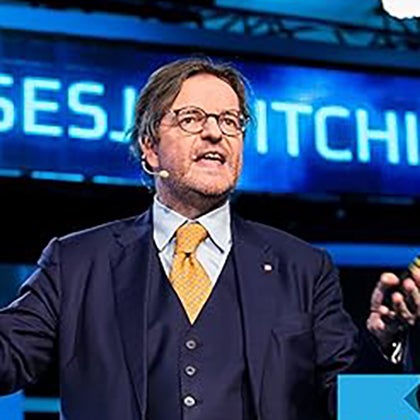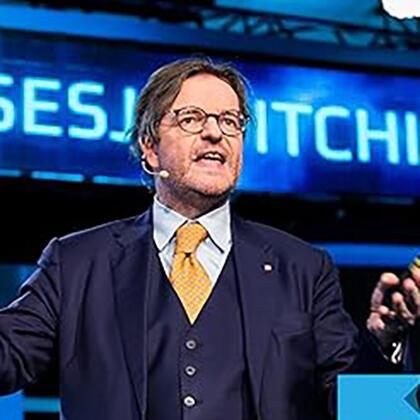Capitalism’s Transparent Failures: Exchanges as the epicentre of markets – a contradiction in terms?
Share
- Details
- Text
- Audio
- Downloads
- Extra Reading
Author Patrick L. Young reviews the exchange landscape over 2,000 years and wonders whether its vaunted position as a capitalist focal point in society is justified. In a world where the exchange is a minority interest pursuit, what is its future, and has the much-lauded golden age of electronic trading already reached its zenith in a developing world?
Download Text
Capitalism's Transparent Failures: Exchanges as the epicentre of markets - a contradiction in terms?
Patrick L Young
Author Patrick L. Young reviews the exchange landscape over 2,000 years and wonders whether its vaunted position as a capitalist focal point in society is justified.
In a world where the exchange is a minority interest pursuit, what is its future, and has the much-lauded golden age of electronic trading already reached its zenith in a developing world?
Good Evening Ladies and Gentlemen, it is my honour to address this audience in the historic surroundings of Gresham College, particularly because Sir Thomas Gresham himself was of course the founder through bequest of this eponymous college. Even more pertinently to my discussion this evening, Gresham was the man who imported the concepts of the Antwerp Bourse to London, building the 'Royal Exchange' as a centrepiece of the City of London. It is humbling to give this lecture in the college founded by the man who first brought the modern exchange concept to the City of London. Moreover, it is only fair that I begin with a word of thanks to the staff at Gresham College for organising this lecture and in particular to Professor Michael Mainelli who originally suggested I might like to give a lecture here in Holborn. It is a pleasure to be here and I look forward to sharing this lecture with you all. Indeed I feel compelled to add that Professor Mainelli deserves additional credit as somebody who has done so much to raise the profile of the relatively new chair of Professor of Commerce at Gresham College. In terms of sharing this lecture I might also add that the Gresham College web site is a brilliant source of erudition on all manners of subjects and to that end I would exhort anybody reading this transcript to please listen to the audio or watch the video as my habit is to extemporize or ad lib during my speeches and to that end, not every single comment I make on the evening may be included in this transcript! Moreover there will be a Q&A opportunity after the speech and these interactions will be recorded on the multimedia stream. During this lecture I will continue to espouse my longstanding distaste for PowerPoint. My gut inclination is to dislike the medium. Moreover I am also inclined to believe that a decade or more hence the business world may yet be immersed in a series of class action lawsuits brought by executives who now involuntarily see bullet points whizzing across their retina at all hours of the day and night! Wary of any such future liability issues, I will continue to eschew PowerPoint to the utmost! Nevertheless, while that particular vestige of technology does not appeal to me, I remain a strong advocate for all manner of technological innovation and indeed the exchange world has been entirely revolutionised by the impact of technology during the past decade. Indeed the Gresham College web site itself is a very good example of this as I have noted that a quotation I made about the weather 'The trouble with weather forecasting is that it's right too often for us to ignore it and wrong too often for us to rely on it' was used by Professor Mainelli in a Gresham lecture(1) and subsequently has been widely popularised on the Internet. A quick Google search of the above quotation and its many thousands of mentions, remind us just how much networked technology has changed our world during the past 20 years. This is certainly true of our core topic this evening, exchanges, organised markets or bourses, depending on your preferred term - I will liberally apply all three terms this evening during our old-fashioned person to person dialogue in this magnificent Barnards Inn hall. For a very long time exchanges were hardly bastions of high technology. Indeed, one could argue that for many centuries, millennia even - the structure of exchanges was a matter of pressing indifference to humanity. Wherever we look for early exchanges models whether it is in the ancient market places of Egypt or elsewhere. True there were developments along the way. Forward commodity contracts existed as long as 4000 years ago (King Hammurabi of Mesopotamia goes down in history as the first regulator of such contracts!) and spread to Hellenistic Egypt and the Roman world(2). Japanese rice merchants were at the forefront of developing oriental futures contracts at the Dojima Rice Exchange of Osaka which was established in 1697. Double entry book keeping was developed in Genoa and nudged along the development of the company and hence the trading of their shares. Nevertheless, until the 19th century, from a tabloid perspective it is fair to say that as a story 'Man Bites Dog" had no serious competition from the world's exchange markets. In the 19th century it was the telegraph revolution that produced the first "shock' of any great consequence to the exchange. Particularly in the United States of America, the effect of the telegraph was to remove trading from the smaller inland (3) trading centres and polarise the equity exchange business on the coasts: San Francisco in the west and the original US markets, Boston, New York and Philadelphia on the eastern seaboard. Thereafter another century of stasis in market structure was evident. Indeed, it is fair to say that a reader of the classic trader's tale "Confusion de Confusionses" by the Portuguese stockbroker José de La Vega could find in his brilliant portraits of Amsterdam floor traders in the 17th century, characters who were still clearly apparent on market floors across the world more than 300 years later.(4) So even in the post World War II period, the US exchanges had polarised to the coasts and the European markets were mostly finding a nucleus around the major financial centre (e.g. London, Paris, Milan and Frankfurt albeit within a still relatively fragmented German exchange environment). Most of the world's nations have continued to cling to the belief that a measure of their national virility is tangibly measured by having a bourse held named for the nation (or its capital). However, in the 1960s, it was in the United States where - inadvertently - the greatest developments in modern capital markets began to take shape. The Camelot of John F Kennedy has been widely regarded as a remarkable period in US history. Indeed from the narrow sphere of exchange markets and financial centres, it has to be regarded as a most interesting time although our focus tonight leaves us short on praise for the government of the era. Indeed, the 1960's was a frankly disastrous time for US market structure but an exciting one for overseas centres and exchanges as the Kennedy administration's desire to tax all manner of activities led to a huge outflow of business overseas. In the process, the post-Imperial capital city of London found its sleepy financial centre suddenly energised and the process of modernisation to become the contemporary colossus alongside New York was initially driven by the Democratic administration's raft of withholding tax. With such onshore tax levies came trading overseas in US equities and bonds, the birth of the Eurodollar market for overseas US denominated deposits and the creation of the Eurobond markets for corporate debt. All told, the Kennedy administration may be an interesting parallel to draw with the current "new Camelot" where of course the President has already spent considerable time attacking overseas trading and looking at re-regulating many aspects of not merely US markets but also seeking extra-territorial influence overseas. The Kennedy era legacy created fertile ground for a break with the regressive taxation of the Democrats' policies. As I mentioned a few moments ago, this lecture focuses only on the narrow arena of exchanges and financial markets. Within that context it is interesting to note that what was a notable failure in US policy to contain markets during the 1960s led to the most magnificent deregulation of markets, begun by a President who is somewhat less favourably remembered than would be the case if he were only to be judged on his incredible impact on financial market infrastructure. Richard Millhouse Nixon may be recalled for the Watergate scandal but in the realm of exchanges, his government can only be judged as a marvellous success with enormous ramifications for the world's future trade and economic growth. Nixon, it will be recalled, withdrew the US from the Bretton Woods agreement. This may have been an issue for economists in many other respects but it has been a huge boon for all aspects of global financial markets. Nixon's decision to abandon the gold standard and let the US dollar float was followed up by his deregulation of commissions in the US stock market. It seems rather difficult to believe that until the mid 1970's the world's largest stock market operated a fixed price commission system that levied the same charge to all users! Bizarrely, this system was beloved of the Wall Street brokers who were up in arms (to put it mildly) at the idea of free market competition over their charges! Capitalism in action was hardly the watchword for stock markets during the post war era. Indeed it took decades before many other major exchanges in the world were able to adopt the same free market approach to brokerage. Thatcherite Britain led the way in 1985 but even until recent times, several notable nations remained hold-outs to the idea of brokerage price competition. Yet Nixon's visionary deregulation was in fact the greatest event ever in the history of exchange development. The fact that the market professionals completely failed to see the enormous opportunity ahead reminds me of the Economist Magazine noting tersely that: "Financial services firms are not good at coping with rapid change." Ultimately the Nixon reforms would grow the exchange business - and global trading on and off exchanges, by a greater amount than ever in history. Banks and brokers were forced to look beyond hefty charges for plain vanilla transactions and had to find a way to provide value for their services. The end result has quite simply been the greatest period of financial innovation in history. In terms of the modern exchange marketplace, it is only fair to mention that this 'is a derivatives world' as I have been wont to remark for several years. That is not to say that cash markets do not play a key role but rather that the key growth in the exchange (and OTC) business has been in derivatives products. Indeed derivatives products have played a key role in improving cash markets! When the LIFFE exchange was first being established, many bankers were concerned that the illiquid London Inter-Bank market for Sterling deposits would not be a sound basis for a futures contract. Yet, the reality was that within a couple of years of the establishment of the LIFFE market (within, I would note the Royal Exchange building itself) the Short Sterling futures contract had developed alongside a significant liquidity improvement in the 3 month Sterling deposit market. The original exchange model had, for several millennia, revolved around 'open outcry' trading. However, this too would change as the power of network technology knocked the stuffing out of legacy exchanges with the rise of network technologies in the late 1990's. Thus was the "Capital Market Revolution" born... The origins of the revolution date back to the 1970's. Dr Richard Sandor, the "Father of Financial Futures" (5) is now perhaps better known as the man behind the world's leading environmental products marketplace, the Chicago Climate Exchange and its subsidiaries. However, in 1970 Dr. Sandor was a Professor at the University of California''s Berkeley campus and working as project director on a plan to create the Pacific Commodities Exchange, the world's first all-electronic marketplace. "He envisages no pit, ring or trading floor but an exchange hooked up by a "vast communication network," computers [and] split-second automatic execution of buy-sell orders."(6) An electronic futures exchange in Bermuda was also mooted but overall plans generally failed to get off the ground until a Swede, Olof Stenhammer launched OM in Stockholm in 1985 and created the new model marketplace. OM was an all-electronic marketplace - indeed OM's technology would subsequently become the most broadly distributed exchange technology in the world with more than 70 installations world-wide. OM was the world's first for profit exchange to be listed on a stock market. In every respect, OM was a trailblazer. Ultimately the OMX group which comprised most of the markets of Scandinavia and the Baltic states was acquired by NASDAQ in 2007. With the rise in network technology, it became increasingly clear that the trading network was being powered by the existing technology vendors, i.e. the data and news vendors such as Reuters and Bloomberg. Intriguingly, the legacy exchanges themselves really failed to understand the power of their own networks and how they needed to cope with the future. Then again, it has to be understood that the mutual exchange was often not an example of flexible capitalism at its best! The staff of exchanges, like so many in financial markets, are essentially process driven and therefore not necessarily apt at understanding longer-term strategic issues, particularly not when it comes to major disruptive developments. Similarly, with management usually chosen by boards created of non-executives from member organisations, it is fair to say that a multiplicity of issues of control have also led to exchanges choosing less dynamic individuals to manage their markets and thus ending up with a void when such disruptive developments occur. Similarly, and even today, legacy exchanges are challenged by governance issues of which a simple example is the size of the boards themselves. Microsoft Corporation seems to function rather well with 10 board members. Are exchanges better served by having anything up to 30 members of their boards? In the late 1990's the electronic market shock hit exchanges rapidly and legacy markets were not remotely prepared. It is also fair to say that there were even some board members who demonstrated a modicum (to put it mildly!) of disingenuity when it came to advising different exchanges to take opposing paths to implementing technology and retaining open outcry. By the time my first book "Capital Market Revolution!" was published on July 1st 1999, the exchange world looked very different to its current position. The LIFFE market in London was on its knees, after sticking to open outcry and losing key market share to the all-electronic EUREX which had only been launched in 1990 (some 8 years after LIFFE). Meanwhile, the Chicago Mercantile Exchange, nowadays viewed as a leading publicly quoted exchange market appeared on the verge of outright civil war. The major factions eventually settled on Scott Gordon as a compromise candidate for Chairman. Gordon, determined to secure the future of the exchange helped create a revolution within CME, bringing in Jim McNulty as CEO. Together they created the basis for the CME to make the metamorphosis from an institution on the brink to becoming a genuine powerhouse business. At the Chicago Board of Trade, the exchange was in even worse shape during 1999 than the CME. Unlike CME, the CBOT's internal politicking never quite allowed the exchange to recover and eventually the original US futures exchange and the market leader from 1848 until well into the 1990's was subsumed into the resurgent CME. Meanwhile, there were left field players such as EUREX the Zurich based exchange made up of a merger of Germany and Switzerland's futures markets. Both exchanges had deployed IT from their inception and EUREX was able to ruthlessly exploit the multiple process and cost advantages against the previous European leading exchange LIFFE, bringing the London marketplace to the brink of bankruptcy. As the Capital Market Revolution continued to gain momentum, the legacy exchanges all began to exploit electronic trading and diminish (if not close outright) their floor operations. The biggest winners of the period were all newcomers. Amongst them was the National Stock Exchange of India which blitzed the century-old Bombay Stock Exchange to become India's largest stock exchange during the 1990s. Then there were the two 'ice' exchanges. Intercontinental Exchange (ICE) has been driven by the self-confessed opportunist Jeff Sprecher to become a leading player in energy markets and latterly financial products too. Meanwhile the International Securities Exchange (ISE) demonstrated precisely how to become a leading marketplace in your segment through pragmatic deployment of technology. The incumbent equity options markets in the USA share common clearing at OCC (the Options Clearing Corporation) but in 2000 A.D. the US equity options markets were not merely open outcry but like other American markets, the 'one member one vote' democracy with a preponderance of independent seat owners meant the management was largely captive to keeping the floors open. One might also argue that the US equity options exchanges often had management which did not really appreciate that IT would also clearly affect their business model (in every possible respect). In this rather reactionary environment, two visionary individuals, David Krell and Gary Katz created the first US electronic options market. Their impact was simply incredible...having rapidly become the leading options exchange in the USA wherever ISE was permitted to compete, the business itself was sold in 2007 to EUREX for 2.7 billion dollars. Yet the truth is that exchanges have usually only retained some 20-30% of the overall trading business. The OTC money market for instance, dwarfs the amount of interest rate and bond trading on the world's exchanges. However, here we reach an interesting point in our core discussion this evening. A little more than a year ago, exchanges could easily have been swept under the carpet as almost an irrelevance in the trading world. Yet, during the past 12 months we have seen exchanges reign supreme as they were frequently the only functioning trading venues compared to OTC markets which had simply locked solid as a result of concerns about counterparty credit. To this end, the exchange industry can thank the Central Counterparty clearing (CCP) model which began in the futures markets and has gradually infused itself into cash equities trading during the past decade. In essence, the debate between exchange and OTC trading relates to the tilt away from the central market permitting trading to take place in other venues. Certainly when it comes to the ECN/MTF movement, it is not unreasonable to suggest that in certain respects exchanges get a fairly raw deal as they are left with considerable legacy activity such as self-regulatory functions while the competing platforms are not under the same degree of responsibility in many areas. Then again one can easily argue that the exchanges have in essence been the catalysts for the new wave of competing alternative platforms to their existing quasi-monopolies. In the 1990's the legacy exchanges were utterly asleep at the wheel when new technology came along. This made for a curious scenario where many of the new breed of electronic trading platforms, ECNs (standing for Electronic Communications Networks) were snapped up by the legacy exchanges in order to help them accelerate their technology programmes. Archipelago and the New York Stock Exchange is perhaps the best example of how a (s)lumbering giant transformed itself overnight into a public company with a form of reverse takeover. The ECN Archipelago, having previously acquired the Pacific Coast Stock Exchange (in San Francisco) was a quoted entity and NYSE under John Thain accelerated the process of re-engineering the business by going public through a reverse takeover of the Archipelago business. In the current environment, post dot com there was a hiatus but now the ECNs have returned. As is the wont of financiers and technologists, nowadays the ECNs or Alternative Trading Systems (ATS) have become MTFs: Multilateral Trading Facilities. Their core business model is the same - rapid and very cheap processing of equity transactions. Moreover in this phase of their development, IT advancement has made them a lot cheaper to develop too. At the same time, their fundamental problem remains an inability to make money, Ironically when many such platforms have gained a degree of critical mass they often turn themselves into exchanges to try and garner additional sources of revenue from listing fees or data etc. This in itself would appear to be a recommendation for the underlying exchange model! Meanwhile, back in the OTC marketplace as a whole, there remains what one might describe a certain 'Popular Delusion and the Madness of Bankers' issue (after Mackey(8)). The politically charged nature of the banker-exchange relationship cannot be under-estimated. Relations have soured, particularly in recent years, although one cannot help but note that this is at least partially the bankers' own fault. Originally as I mentioned earlier, exchanges had large boards which tended to reflect the make-up of the membership and thus banks were able to influence the management of the markets. However, when exchanges suddenly offered windfall profits as they demutualised and listed, bankers rushed to take the money and did little thinking about the influence they had lost... For the past several years, bankers and their lobby groups have been trying through various means to reassert this influence. Certainly banks and investment banks are vital partners for exchanges. However, there is also evidence of the vague 'delusion' I mentioned earlier. Essentially, investment bankers are convinced that as almost all orders come through their offices in one way or another that they actually 'own' the order flow of all market participants. This is not to dispute that the quantity of trading on their proprietary or product structuring books is not considerable. Similarly private clients using banks and brokers can be regarded as rather 'sticky.' However, the end user investors utilising the world's exchanges can hardly be deemed to be only trading as a result of the interface that the bank provides for them. This is the heart of what I regard as that investment banker delusion where they see themselves as owners, if not the eternal 'keepers' of order flow! Of course there is the fact that most developed liquid exchanges nowadays tend to have something like 30-35% of their business emanating from the end users while the remaining 65-70% is all accounted for by short term traders, market makers and proprietary traders at banks etc. In that respect, the weight of bankers is not to be under-estimated but at the same time one does have to wonder whether exchanges themselves ought not to be working harder to actually have a greater proportion of their volume derived from end users? Indeed on that point, it is only fair to point out that while speed may be of the essence in that old English saying, it is fair to say that also one can have too much of a good thing! In that respect the current arms race that has built up amongst all manner of algorithmic traders and exchanges seeking ever more rapid market access has gone from providing a highly useful acceleration of the trade process in real-time, to a situation where the potential to trade in micro and milliseconds has in many ways reduced the exchange to being higher volume but arguably less productive to its end users, the long term funds and the issuers. After all, if a fine merchant in a city such as Boston or Hanover is considering listing their privately held company on the stock exchange, does it really convince them that the exchange understands their business and will do a sound job of capital raising and so forth when the bourse itself is increasingly obsessed about paring another millisecond from their execution speed? When it comes to clearing and settlement, this business has long been lauded as the Cinderella element of the exchange industry. Yet in the past year, the effectiveness of exchanges and the failures in the OTC market have been clearly exacerbated as a result of the CCP clearing business. In conclusion, ladies and gentlemen, I am inclined to note a simple fact: exchanges do what it says on their description box. They provide speedy, accurate and reliable transactional processing at a remarkably low cost. Exchanges are shining examples of commoditisation at its best. If only - and I speak from years of bitter experience here - British retail banks could manage the same thing! Sir Brian Williamson, as Executive Chairman of the LIFFE exchange (which he had originally helped to found) when he rescued that market from near oblivion surmised the exchange neatly in 1999: "Exchanges really are a rather low form of life. There is a tendency to look at exchanges as one of three things: as a utility, as an institution, or even, God forbid, as part of the social fabric. Rather the business of the exchanges is high yield, low value. The exchange is a servant of markets."(9) One can clearly argue that the contemporary exchange is, thanks to the considerable injection of network technology in the past decade, simply the most efficient processing entity in human history. Then again, it is fair to argue that processing efficiency must not be permitted to become low latency absurdity! At the same time, the threats to the exchange itself are highly significant. Nevertheless, credibility remains key in all financial markets. Exchanges, by their very definition, must be the agents of utmost credibility. Overall exchanges achieve this brilliantly although they do have some notable foibles. For one thing, their ability to process large 'block' orders, particularly in cash markets, is not strong. To that end, the value-additive 'dark pool' has a highly significant role to play in helping end user institutions transact portfolio change. Exchanges need to address such issues through competitive initiatives to create 'a better mousetrap' as opposed to seeking to regulate them out of existence. Meanwhile, the exchange serves as a beacon to the freedom of society. The magnificent transformation of 1989 that killed the ludicrous Marxist Soviet Empire and brought freedom to millions is by far the most wonderful development of my lifetime. It is intriguing to note that soon after the many new democracies of CEE and SEE achieved their freedom, there was a move to (re-)establish a stock market in the capital cities to demonstrate that now the nation was free...and a capitalist beacon was created. In that respect alone, the exchange serves a wonderful purpose as a demonstration that markets can make everybody wealthy, deliver economic growth and improve prosperity for the entire population. At the same time, it is interesting to reflect that the western exchanges had often become rather static entities with bloated committee structures and massive boards of nomenklatura during the post World War II period. The fact that even today some exchanges retain a structure whereby a central committee chooses an official slate of board candidates ahead of elections does tend to make one wonder just what the 'cutting edge' of capitalism was thinking during the Cold War era. Nevertheless, the fact is that in terms of pure market share, yes, exchanges are indubitably a transparent failure of sorts. However, organised exchange markets perform a vital function without which world trade (and all the trappings of prosperity that accompany it) would be much smaller. There are many potential conflicts of interest and contradictions within the exchange model. However, somewhere in the trading process, markets create a core reference point without which no other markets could coherently function. That centre point of commerce, ladies and gentlemen, is the Exchange! References (1) "Perfectly unpredictable: Why forecasting produces useful rubbish" by Professor Michael Mainelli 28/01/2008. (2) Weber, Ernst Juerg , A Short History of Derivative Security Markets (June 2008). Available at SSRN: http://ssrn.com/abstract=1141689 and Courtney, David, "From Forum to Futures" Credit Lyonnais Rouse, London, 1991. (3) Young, Patrick L, "Capital Market Revolution!" Financial Times Prentice Hall, 1999. (4) De La Vega, José, Confusion de Confusiones, Amsterdam 1688 (and multiple subsequent imprints). (5) An honour first accorded by Mayor Daly of Chicago some years ago. (6) "West Coast looks to the Futures" Financial Times, June 25th, 1970. (7) http://www.nasdaqomx.com/whatwedo/markettechnology/provenpartner/ (8) Mackey, Charles, "Extraordinary Popular Delusions and the Madness of Crowds" (multiple editions) and downloadable at: http://www.archive.org/details/extraordinarypop014178mbp (9) Young, Patrick L, "Capital Market Revolution!" Financial Times Prentice Hall, 1999.
©Professor Patrick L Young, Gresham College
This event was on Thu, 29 Oct 2009
Support Gresham
Gresham College has offered an outstanding education to the public free of charge for over 400 years. Today, Gresham College plays an important role in fostering a love of learning and a greater understanding of ourselves and the world around us. Your donation will help to widen our reach and to broaden our audience, allowing more people to benefit from a high-quality education from some of the brightest minds.


 Login
Login







